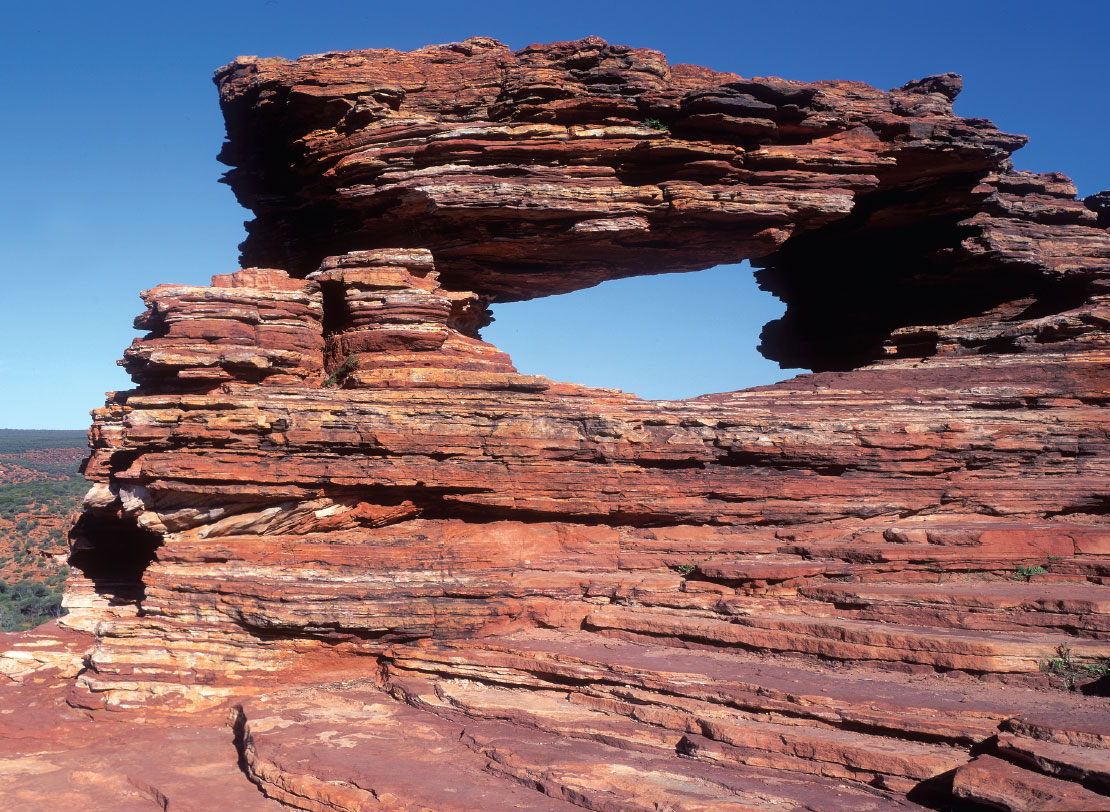

[ NATURE’S WINDOW, KALBARRI NATIONAL PARK ]
WESTERN AUSTRALIA is defined by its size. Spanning an area of 2.5 million square kilometres, it covers one-third of the Australian continent. In dramatic contrast to its size, its population is just over two million, around one-tenth of Australia’s total population. Over 72 per cent of Western Australians live in or around the capital city of Perth.
Within this great state there are incredibly diverse landscapes – an ancient terrain of rugged ranges and dramatic gorges to the north, towering forests to the south, arid deserts to the east and 12 889 kilometres of the world’s most pristine coastline to the west. To match the huge variety in landscape are huge differences in climate, from the tropical humidity of the north and the dryness of the desert to the temperate Mediterranean-style climate of the south-west.
After driving for hours along empty highways, you will get a true feeling for the state’s vastness. But you will be amply rewarded when you reach your destination. Western Australia boasts precious natural features, including the 350-million-year-old Bungle Bungle Range, the limestone sentinels of the Pinnacles desert and the majestic karri forests of the south-west.
There is the extraordinary marine life of Ningaloo Reef, the friendly dolphins of Monkey Mia and Rottnest Island’s famous quokkas.
Western Australia’s historic sites are also a highlight. The Aboriginal people who first inhabited the land up to 65 000 years ago left a legacy of distinctive rock art. Albany, the site of the state’s first European settlement in 1826, boasts wellpreserved heritage buildings, while gracious 19th-century buildings in the capital city of Perth and its nearby port of Fremantle hark back to the days of the Swan River Colony. Remnants of great gold discoveries remain around Coolgardie and Kalgoorlie from the 1890s, which transformed Western Australia into one of the world’s great producers of gold, iron ore, nickel, diamonds, mineral sands and natural gas.
![]()
Population 2 346 400
Total land area 2 529 875 square kilometres
People per square kilometre 0.8
Sheep and cattle per square kilometre 9.8
Nearest interstate city Adelaide, 2700 kilometres east
Length of coastline 12 889 kilometres
Number of islands 3747
Longest river Gascoyne River (760 kilometres)
Largest constructed reservoir Lake Argyle (storage volume 10 760 million cubic metres)
Highest mountain Mount Meharry (1253 metres), Karijini National Park
Highest waterfall King George Falls (80 metres), northern Kimberley
Highest town Tom Price (747 metres)
Hottest place Marble Bar (160 days a year over 37.5°C)
Coldest place Bridgetown (33 days a year begin at below 2°C)
Most remote town Warburton
Strangest place name Walkaway
Most famous local Rolf Harris
Quirkiest festival Milk Carton Regatta, Hillarys Boat Harbour
Number of wildflowers 12 500 species
Most challenging road Gibb River Road, the Kimberley
Best beach Cable Beach, Broome
Most identifiable food Pavlova (created at Perth’s Esplanade Hotel)
Local beer Swan Lager